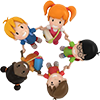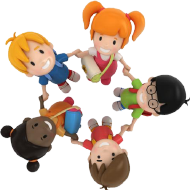Today, many more babies have flat spots on their heads, a huge increase from 20 years ago. In fact, it is now common to see babies out in public wearing orthotic helmets and to hear stories about their courses of physical or occupational therapy. In the 1970’s, studies showed that 1 in 300 infants were diagnosed with plagiocephaly (flat head); current numbers are as high as 1 in 2 with up to 1 in 6 receiving treatment.
Positional plagiocephaly is a deformation of the skull bones in an oblique shape due to prolonged pressure on one part of the skull. Infants’ skull bones are not yet sutured together. Skull shape is dependent upon the forces placed upon the bones, internally from brain growth and muscle pulls, and externally from surfaces and gravity. Plagiocephaly is categorized as mild, moderate, or severe depending on the measured difference between the skull’s left and right diagonals.
Torticollis, is a shortening of the sternocleidomastoid (SCM) muscle. It presents as a head tilt to one side (ear to shoulder) and a turn to the opposite side (chin toward opposite shoulder). Parents often notice that baby has a preference for turning and holding her head either left or right.
 Positional plagiocephaly has increased substantially since 1992, coinciding with the American Academy of Pediatrics’ recommendation that babies be placed on their backs to sleep to reduce the risk of SIDS, as well as the rise of our container culture.
Positional plagiocephaly has increased substantially since 1992, coinciding with the American Academy of Pediatrics’ recommendation that babies be placed on their backs to sleep to reduce the risk of SIDS, as well as the rise of our container culture.
Still important for babies to sleep on their backs
Despite this unintended consequence of flat heads from safe sleeping positions on their backs, it is important for babies to sleep on their backs to reduce the risk of SIDS. In addition, babies are too often placed in all the accessories for on-the-go babies; infant seats, swings, walkers, and jumpers, rather than carrying the baby or simply placing the baby on the floor, where real development occurs.
Plagiocephaly and torticollis often go hand in hand because young infants have poor head control as they learn how to move against gravity. If a baby has a flat spot on one side, she will more likely hold her head with that spot against the ground, crib mattress, car seat, or infant carrier. As that flat spot rests against the surface, it becomes larger and broader over time, which also affects the length of the muscles attached to that bone. As time goes by, it is a vicious cycle that causes each diagnosis to become more severe.
These diagnoses may be present at birth, but can often be remedied without the need for physical or orthotic therapies. It merely requires careful observation and tracking over time as well as consistent implementation of a few simple interventions.
What to look for:
- Does your baby look and/or allow you to position her head in both directions equally?
- Does she spend equal time gazing left and right?
- Does she have the same range of motion on both sides? A baby’s chin should easily reach over her shoulder without restriction.
- Does your baby have a side bend in her neck and body rather than symmetry from right to left? This is best observed when you are at baby’s feet, looking up toward her head.Looking at your baby’s head from top down, draw an imaginary line from her nose to the back of her skull. Are the sides equal in shape? Are the ears lined up across from one another?
- Does the back of baby’s head look abnormally flat with protrusion just behind the ears on one or both sides? A baby’s head should be longer from front to back than it is wider from side to side.
- Feel around your baby’s head. Does it feel equally round with smooth curves on both sides, or are there noticeable flat spots?


- Discuss concerns with your pediatrician and gain as much information as you can from knowledgeable medical professionals.
- Maximize baby’s awake tummy time to keep pressure off of flat spots and to allow the ground and gravity to stretch out any tight muscles. Young infants cannot sustain a head lift when on their tummies and are perfectly happy to rest head on floor.
- Minimize baby’s container time, such as in car seats, infant seats, strollers, and swings, where your baby’s head is resting against a surface. When you need to have baby in a container, position and support her head so the flat spot is not resting on a surface.
- Position your baby with head and body in midline or to non-preferred or non-flat side whenever possible. Motivating visual stimuli and swaddling can be used to assist in this effort.
- Awake: Many young infants love looking at lights. Consider placing baby on changing table and other play surfaces so she is motivated to look towards the lights or other interesting stimuli on her non-preferred side. When playing with your baby, position your face and body to the non-preferred side 75% of the time. You still want her to spend time looking toward the preferred side!
- Asleep: Swaddle baby with body symmetrical, hands up toward face rather than pinned down to the side or in front of body. You can position one hand higher so she turns her head for hand to mouth contact on non-preferred side. You may need professional support or guidance for this strategy.
- Monitor (at least weekly) flat spot and neck range of motion and note if they are getting better or worse. Consider taking photos of head shape (especially looking down at top of head) to track over time. Share your concerns and/or findings with your pediatrician.
- The earlier asymmetries are observed and addressed conservatively, the faster and more complete the resolution. Awake tummy time, when started early and practiced often, is the most effective strategy to prevent and/or minimize both conditions. More pronounced asymmetries that persist for several weeks should be evaluated further for possible physical or occupational therapy or orthotic/helmet intervention.
- Children’s Therapy Connections Physical and Occupational therapists provide therapeutic treatment for torticollis and provide parental guidance to reduce flat head along with recommending appropriate assistive technology when additional assistance is needed.


